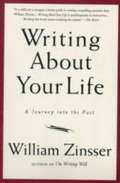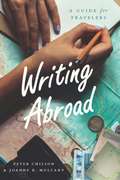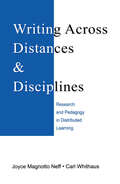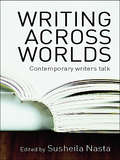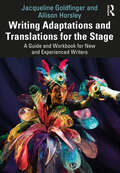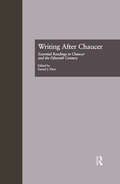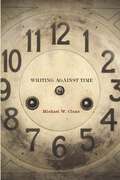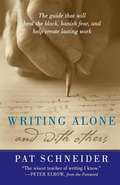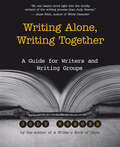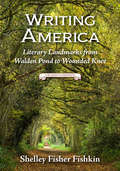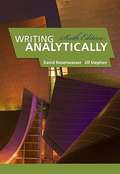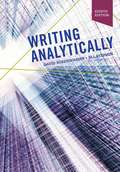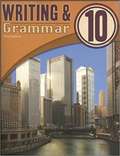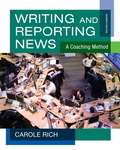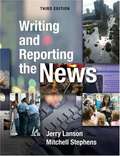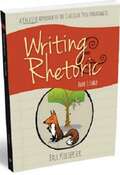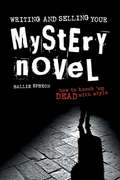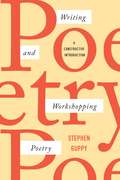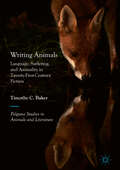- Table View
- List View
Writing About Your Life: A Journey into the Past
by William ZinsserOn Writing Well gives you the tools to organize and recover your past, and the confidence to believe in your life narrative. His method is to take you on a memoir of his own: 13 chapters in which he recalls dramatic, amusing, and often surprising moments in his long and varied life as a writer, editor, teacher, and traveler. Along the way, Zinsser pauses to explain the technical decisions he made as he wrote about his life.
Writing Abroad: A Guide for Travelers
by Peter Chilson Joanne B. Mulcahy“Tell me all about your trip!” It’s a request that follows travelers as they head out into the world, and one of the first things they hear when they return. When we leave our homes to explore the wider world, we feel compelled to capture the experiences and bring the story home. But for those who don’t think of themselves as writers, putting experiences into words can be more stressful than inspirational. Writing Abroad is meant for travelers of all backgrounds and writing levels: a student embarking on overseas study; a retiree realizing a dream of seeing China; a Peace Corps worker in Kenya. All can benefit from documenting their adventures, whether on paper or online. Through practical advice and adaptable exercises, this guide will help travelers hone their observational skills, conduct research and interviews, choose an appropriate literary form, and incorporate photos and videos into their writing. Writing about travel is more than just safeguarding memories—it can transform experiences and tease out new realizations. With Writing Abroad, travelers will be able to deepen their understanding of other cultures and write about that new awareness in clear and vivid prose.
Writing Across Cultures
by Robert Eddy Amanda Espinosa-AguilarWriting Across Cultures invites both new and experienced teachers to examine the ways in which their training has—or has not—prepared them for dealing with issues of race, power, and authority in their writing classrooms. The text is packed with more than twenty activities that enable students to examine issues such as white privilege, common dialects, and the normalization of racism in a society where democracy is increasingly under attack. This book provides an innovative framework that helps teachers create safe spaces for students to write and critically engage in hard discussions. Robert Eddy and Amanda Espinosa-Aguilar offer a new framework for teaching that acknowledges the changing demographics of US college classrooms as the field of writing studies moves toward real equity and expanding diversity. Writing Across Cultures utilizes a streamlined cross-racial and interculturally tested method of introducing students to academic writing via sequenced assignments that are not confined by traditional and static approaches. They focus on helping students become engaged members of a new culture—namely, the rapidly changing collegiate discourse community. The book is based on a multi-racial rhetoric that assumes that writing is inherently a social activity. Students benefit most from seeing composing as an act of engaged communication, and this text uses student samples, not professionally authored ones, to demonstrate this framework in action. Writing Across Cultures will be a significant contribution to the field, aiding teachers, students, and administrators in navigating the real challenges and wonderful opportunities of multi-racial learning spaces.
Writing Across Difference: Theory and Intervention
by James Rushing Daniel Candice Rai Katie MalcolmAs the nation becomes increasingly divided by economic inequality, racial injustice, xenophobic violence, and authoritarian governance, scholars in writing studies have strived to develop responsive theories and practices to engage students, teachers, administrators, and citizens in the crisis of division and to begin the complicated work of radically transforming our inequitable institutions and society. Writing Across Difference is one of the first collections to gather scholars from across the field engaged in offering theoretical, methodological, and pedagogical resources for understanding, interrogating, negotiating, and writing across difference. No text in composition has made such a sweeping attempt to place the multiple areas of translingualism, anti-racism, anticolonialism, interdisciplinarity, and disability into conversation or to represent the field as broadly unified around the concept of difference. The chapters in this book specifically explore how monolingual ideology is maintained in institutions and how translingual strategies can (re)include difference; how narrative-based interventions can promote writing across difference in classrooms and institutions by complicating dominant discourses; and how challenging dominant logics of class, race, ability, and disciplinarity can present opportunities for countering divisiveness. Writing Across Difference offers writing scholars a sustained intellectual encounter with the crisis of difference and foregrounds the possibilities such an encounter offers for collective action toward a more inclusive and equitable society. It presents a variety of approaches for intervening in classrooms and institutions in the interest of focalizing, understanding, negotiating, and bridging difference. The book will be a valuable resource to those disturbed by the bigotry, violence, and fanaticism that mark our political culture and who are seeking inspiration, models, and methods for collective response. Contributors: Anis Bawarshi, Jonathan Benda, Megan Callow, James Rushing Daniel, Cherice Escobar Jones, Laura Gonzales, Juan Guerra, Stephanie Kerschbaum, Katie Malcolm, Nadya Pittendrigh, Mya Poe, Candice Rai, Iris Ruiz, Ann Shivers-McNair, Neil Simpkins, Alison Y. L. Stephens, Sumyat Thu, Katherine Xue, Shui-yin Sharon Yam
Writing Across Distances and Disciplines: Research and Pedagogy in Distributed Learning
by Joyce Magnotto Neff Carl WhithausWriting Across Distances and Disciplines addresses questions that cross borders between onsite, hybrid, and distributed learning environments, between higher education and the workplace, and between distance education and composition pedagogy. This groundbreaking volume raises critical issues, clarifies key terms, reviews history and theory, analyzes current research, reconsiders pedagogy, explores specific applications of WAC and WID in distributed environments, and considers what business and education might teach one another about writing and learning. Exploring the intersection of writing across the curriculum, composition studies, and distance learning , it provides an in-depth look at issues of importance to students, faculty, and administrators regarding the technological future of writing and learning in higher education.
Writing Across Worlds: Contemporary Writers Talk
by Susheila NastaWriting Across Worlds brings together a selection of interviews with major international writers previously featured in the pages of the magazine. Conducted by a wide constituency of distinguished critics, writers and journalists, the interviews offer a unique insight into the views and work of a remarkable array of acclaimed authors. They also chart a slow but certain cultural shift: those once seen as 'other' have not only won many of the establishment's most revered literary prizes but have also become central figures in contemporary literature, writing across and into all our real and imagined worlds. With an introductory comment by Susheila Nasta, editor of Wasafiri, this collection is essential reading for all those interested in contemporary literature. Authors interviewed include: Chinua Achebe, Ama Ata Aidoo, Monica Ali, Amit Chaudhuri, David Dabydeen, Bernadine Evaristo, Maggie Gee, Lorna Goodison, Nadine Gordimer, Abdulrazak Gurnah, Wilson Harris, Keri Hulme, Kazuo Ishiguro, Jackie Kay, Jamaica Kincaid, Maxine Hong Kingston, George Lamming, Rohinton Mistry, V.S. Naipaul, Ngugi wa Thiong'o, Michael Ondaatje, Caryl Phillips, Joan Riley, Salman Rushdie, Nayantara Sahgal, Sam Selvon, Vikram Seth, Zadie Smith, Wole Soyinka, Moyez Vassanji, Marina Warner.
Writing Adaptations and Translations for the Stage: A Guide and Workbook for New and Experienced Writers
by Jacqueline Goldfinger Allison HorsleyWriting Adaptations and Translations for the Stage is a practical guide for writing adapted works for theatrical performance. Broadway translator and dramaturg Allison Horsley and award-winning playwright and educator Jacqueline Goldfinger take readers step-by-step through the brainstorming, writing, revision, and performance processes for translations and adaptations. The book includes lectures, case studies, writing exercises, and advice from top theater professionals on the process of creating, pitching, and producing adaptations and translations, covering a wide range of topics such as jukebox musicals, Shakespeare adaptations, plays from novels, theater for young adults, and theater in translation and using Indigenous language. Artists who share their wisdom in this book include: Des McAnuff (Tony Award), Emily Mann (Tony Award), Dominique Morisseau (Broadway Adaptor, Tony Award nominee, MacArthur Genius Fellow), Lisa Peterson (Obie Award, Lortel Award), Sarah Ruhl (Broadway Playwright, Tony Award nominee, Pulitzer Prize finalist, MacArthur Genius Fellow), and Tina Satter (Broadway Director, Obie Award, Guggenheim Fellowship). The book also features interviews with artists working both in the US and internationally, as well as guest columns from artists who work in less traditional adaptive forms including cabaret, burlesque, opera, community-engaged process, and commercial theater. Writing Adaptations and Translations for the Stage is an essential resource for students and instructors of Dramatic Writing, Playwriting, and Creative Writing courses and for aspiring playwrights.
Writing Adaptations and Translations for the Stage: A Guide and Workbook for New and Experienced Writers
by Jacqueline Goldfinger Allison HorsleyWriting Adaptations and Translations for the Stage is a practical guide for writing adapted works for theatrical performance.Broadway translator and dramaturg Allison Horsley and award-winning playwright and educator Jacqueline Goldfinger take readers step-by-step through the brainstorming, writing, revision, and performance processes for translations and adaptations. The book includes lectures, case studies, writing exercises, and advice from top theater professionals on the process of creating, pitching, and producing adaptations and translations, covering a wide range of topics such as jukebox musicals, Shakespeare adaptations, plays from novels, theater for young adults, and theater in translation and using Indigenous language. Artists who share their wisdom in this book include: Des McAnuff (Tony Award), Emily Mann (Tony Award), Dominique Morisseau (Broadway Adaptor, Tony Award nominee, MacArthur Genius Fellow), Lisa Peterson (Obie Award, Lortel Award), Sarah Ruhl (Broadway Playwright, Tony Award nominee, Pulitzer Prize finalist, MacArthur Genius Fellow), and Tina Satter (Broadway Director, Obie Award, Guggenheim Fellowship). The book also features interviews with artists working both in the US and internationally, as well as guest columns from artists who work in less traditional adaptive forms including cabaret, burlesque, opera, community-engaged process, and commercial theater.Writing Adaptations and Translations for the Stage is an essential resource for students and instructors of Dramatic Writing, Playwriting, and Creative Writing courses and for aspiring playwrights.
Writing After Chaucer: Essential Readings in Chaucer and the Fifteenth Century (Basic Readings in Chaucer and His Time)
by Daniel PintiThis volume makes available to teachers, students, and scholars a convenient selection of the most provocative and influential articles from the past 20 years on Chaucer's afterlife in the 15th century, one of the most dynamic topics in Chaucer studies today. Much recent work in the field of Chaucer studies has shown how our understanding of Chaucer's poetry is mediated by his 15th-century readers and scribes. Increased scholarly interest in various 15th-century Chaucerian poets-notably Hoccleve, Lydgate, and Henryson-has prompted medievalists to read these sometimes neglected poems anew The classic essays in this volume, plus two written just for this collection, investigate the scribes, glossators, and poets whose reception and transmission of Chaucer's writings influence our own reading of them today, focusing chiefly on the Chaucerian influence in their poetry. Written by eminent Chaucer scholars, these essays cover not only a wide range of Chaucer's writings, but also touch on the history of the English language, the glosses to Chaucer's poetry, English and Scottish poets' appropriations of Chaucer, the implicit criticism and interpretations of Chaucer's writings in the 15th century, and the first printing of Chaucer's works by William Caxton Timely and unique, this collection will prove indispensable for research libraries, a convenient and valuable resource for scholars, and an essential introduction for students.
Writing Against Time
by Michael W. CluneFor centuries, a central goal of art has been to make us see the world with new eyes. Thinkers from Edmund Burke to Elaine Scarry have understood this effort as the attempt to create new forms. But as anyone who has ever worn out a song by repeated listening knows, artistic form is hardly immune to sensation-killing habit. Some of our most ambitious writers—Keats, Proust, Nabokov, Ashbery—have been obsessed by this problem. Attempting to create an image that never gets old, they experiment with virtual, ideal forms. Poems and novels become workshops, as fragments of the real world are scrutinized for insights and the shape of an ideal artwork is pieced together. These writers, voracious in their appetite for any knowledge that will further their goal, find help in unlikely places. The logic of totalitarian regimes, the phenomenology of music, the pathology of addiction, and global commodity exchange furnish them with tools and models for arresting neurobiological time. Reading central works of the past two centuries in light of their shared ambition, Clune produces a revisionary understanding of some of our most important literature.
Writing Alone and With Others
by Peter Elbow Pat SchneiderFor more than a quarter of a century, Pat Schneider has helped writers find and liberate their true voices. She has taught all kinds--the award winning, the struggling, and those who have been silenced by poverty and hardship. Her innovative methods have worked in classrooms from elementary to graduate level, in jail cells and public housing projects, in convents and seminaries, in youth at-risk programs, and with groups of the terminally ill. Now, in Writing Alone and with Others, Schneider's acclaimed methods are available in a single, well-organized, and highly readable volume. The first part of the book guides the reader through the perils of the solitary writing life: fear, writer's block, and the bad habits of the internal critic. In the second section, Schneider describes the Amherst Writers and Artists workshop method, widely used across the U. S. and abroad. Chapters on fiction and poetry address matters of technique and point to further resources, while more than a hundred writing exercises offer specific ways to jumpstart the blocked and stretch the rut-stuck. Schneider's innovative teaching method will refresh the experienced writer and encourage the beginner. Her book is the essential owner's manual for the writer's voice.
Writing Alone, Writing Together: A Guide for Writers and Writing Groups
by Judy ReevesThe lonely life of a writer need not be. There are ways to break that isolation and find encouragement and support within groups of like-minded people. Sections in Writing Alone, Writing Together include Writing Practice Groups, Creating Writing Prompts, Group Leadership, and even What to Do with the Bores, Whiners, Control Junkies, and Thugs. Whether the group is oriented toward writing the great American novel or a family memory book, this useful book offers an array of effective techniques to help writers achieve their goals.
Writing America
by Shelley Fisher FishkinAmerican novelist E.L. Doctorow once observed that literature "endows places with meaning." Yet, as this wide-ranging new book vividly illustrates, understanding the places that shaped American writers' lives and their art can provide deep insight into what makes their literature truly meaningful. Published on the eve of the 50th anniversary of the Historic Preservation Act, Writing America is a unique, passionate, and eclectic series of meditations on literature and history, covering over 150 important National Register historic sites, all pivotal to the stories that make up America, from chapels to battlefields; from plantations to immigration stations; and from theaters to internment camps. The book considers not only the traditional sites for literary tourism, such as Mark Twain's sumptuous Connecticut home and the peaceful woods surrounding Walden Pond, but also locations that highlight the diversity of American literature, from the New York tenements that spawned Abraham Cahan's fiction to the Texas pump house that irrigated the fields in which the farm workers central to Gloria Anzaldúa's poetry picked produce. Rather than just providing a cursory overview of these authors' achievements, acclaimed literary scholar and cultural historian Shelley Fisher Fishkin offers a deep and personal reflection on how key sites bore witness to the struggles of American writers and inspired their dreams. She probes the global impact of American writers' innovative art and also examines the distinctive contributions to American culture by American writers who wrote in languages other than English, including Yiddish, Chinese, and Spanish. Only a scholar with as wide-ranging interests as Shelley Fisher Fishkin would dare to bring together in one book writers as diverse as Gloria Anzaldúa, Nicholas Black Elk, David Bradley, Abraham Cahan, S. Alice Callahan, Raymond Chandler, Frank Chin, Elizabeth Cook-Lynn, Countee Cullen, Frederick Douglass, Paul Laurence Dunbar, Jessie Fauset, William Faulkner, F. Scott Fitzgerald, Allen Ginsberg, Jovita González, Rolando Hinojosa, Langston Hughes, Zora Neale Hurston, Lawson Fusao Inada, James Weldon Johnson, Erica Jong, Maxine Hong Kingston, Irena Klepfisz, Nella Larsen, Emma Lazarus, Sinclair Lewis, Genny Lim, Claude McKay, Herman Melville, N. Scott Momaday, William Northup, John Okada, Miné Okubo, Simon Ortiz, Américo Paredes, John P. Parker, Ann Petry, Tomás Rivera, Wendy Rose, Morris Rosenfeld, John Steinbeck, Harriet Beecher Stowe, Henry David Thoreau, Mark Twain, Yoshiko Uchida, Tino Villanueva, Nathanael West, Walt Whitman, Richard Wright, Hisaye Yamamoto, Anzia Yezierska, and Zitkala-Ša. Leading readers on an enticing journey across the borders of physical places and imaginative terrains, the book includes over 60 images, and extended excerpts from a variety of literary works. Each chapter ends with resources for further exploration. Writing America reveals the alchemy though which American writers have transformed the world around them into art, changing their world and ours in the process. Table of ContentsList of Illustrations Acknowledgments Introduction: The Literary Landscape1 Celebrating the Many in One Walt Whitman Birthplace, Huntington, Long Island, New York2 Living in Harmony with Nature Walden Pond, Concord, Massachusetts3 Freedom's Port The New Bedford Whaling National Historical Park, New Bedford, Massachusetts4 The House that Uncle Tom's Cabin Built Harriet Beecher Stowe House, Hartford, Connecticut5 The Irony of American History The Mark Twain Boyhood Home, Hannibal, Missouri, and the Mark Twain House, Hartford, Connecticut6 Native American Voices Remember Wounded Knee, Pine Ridge Indian Reservation, South Dakota7 "I Know Why the Caged Bird Sings" The Paul Laurence Dunbar House, Dayton, Ohio8 Leaving the Old World for the New The Tenement Museum, New York City9 The Revolt from the Village The Original Main Street, Sauk Centre, Minnesota10 Asian American Writers and Creativ...
Writing America: Language And Composition In Context AP* Edition
by David A. Jolliffe Hephzibah RoskellyWe have designed Writing America: Language and Composition in Context AP* Edition so that it can be used as the foundational text in a course that emphasizes reading, writing, and analyzing texts. Writing America teaches reading as a dynamic, interactive process. It teaches writing as a craft, related to reading, that produces rich, purposeful, well-planned and well-executed texts. It teaches the structure and organization of texts, at the level of both the whole text and the sentence. It couches this instruction in an examination of vitally important works of American literature, art, and culture, accompanied by a study of contemporary pieces that unpack current thinking on the issues and themes raised by the historical works.
Writing Analytically (6th Edition)
by David Rosenwasser Jill StephenRosenwasser and Stephen (Muhlenberg College, Allentown, PA) show undergraduate students in first-year writing courses, as well as those in more advanced writing-intensive courses in various subjects, how to learn to analyze information and use writing to discover and develop ideas. They explain how to become more observant and push observations to implications and conclusions; use evidence, evolve claims, and converse with sources to write analytical papers; and understand organization, disciplinary formats, introductions and conclusions, and grammar and style. Writing exercises that can be applied to print and visual, text-based, and experiential materials are included, as are tips from professors on differences in disciplines other than English, rhetoric, or composition. This edition has a new introductory chapter previewing key topics, more examples, and more lists and rationales. It has two toolkit chapters on analytical methods instead of one, some reorganization and reformatting, more description of discipline-specific writing (especially the natural and social sciences), and new material in chapters on form. It has new sections on Rogerian argument, practical reasoning, and figurative logic, and expanded treatment of the four documentation styles. It clarifies step-by-step instructions, uncovering assumptions, and the method of looking for patterns of repetition and contrast. Another edition of the book includes readings. Annotation ©2012 Book News, Inc. , Portland, OR (booknews. com)
Writing Analytically (8th Edition)
by David Rosenwasser Jill StephenWRITING ANALYTICALLY treats writing as a tool of thought, offering prompts that lead students through the process of analysis and help them to generate original, well-developed ideas. The authors of this brief, popular rhetoric believe that learning to write well requires learning to use writing as a tool to think well. Rosenwasser and Stephen emphasize analysis as a mode of enriching understanding that precedes and in some cases supplants argument. Materials in the eighth edition are better integrated, more contextualized and--when possible--condensed. A new chapter, Thinking Like a Writer, contains a broad array of strategies for integrating opportunities for writing into a course. It makes explicit a subtext that pervades the book: that to think of yourself as a writer is to see more, to think differently and to engage the meaning of things more earnestly.
Writing Analytically, Seventh Edition
by David Rosenwasser Jill StephenWriting Analytically treats writing as a tool of thought, offering prompts that lead you through the process of analysis and synthesis and help you to generate original, well-developed ideas.
Writing And Grammar 10, Student Text
by Elizabeth Rose Kimberly Y. Stegall Dana Gibby Gage Bob Jones University Press StaffWriting & Grammar Grade 10 - Student Text. Teach the eight parts of speech, verbal phrases, clauses (including noun clauses), usage, and mechanics. Review the five basic sentence patterns: S-be-Advl and S-Trv-DO-OC. Reference chapters include library skills such as test-taking strategies. Lead students through the writing process and teach writing strategies such as sentence expansion and reduction, coordination and subordination, and parallelism. Writing projects include persuasive speech, editorial, eyewitness report, research essay, cause-and-effect essay, short story, poetry and metaphor, and webpage design.
Writing And Grammar, Grade 9: Communication In Action
by Pearson Prentice HallStep-by-Step writing process instruction and the detailed concept modeling of Prentice Hall Writing and Grammar helps students improve their writing skills.
Writing And Reporting News: A Coaching Method
by Carole RichPrepare yourself for the changing world of journalism with WRITING AND REPORTING NEWS: A COACHING METHOD, the book that integrates new trends in the convergence of print, broadcast and online media while teaching fundamental skills. With new information about social media, mobile media, blogs, and new skills you'll need for whatever career you choose, the seventh edition features tips, techniques, and real-life stories from writing coaches and award-winning journalists. A strong storytelling approach makes the text accessible and interesting, helping you easily master the writing and reporting techniques you'll need for media careers now and in the future.
Writing And Reporting The News
by Mitchell Stephens Jerry LansonWriting and Reporting the News, Third Edition, is a comprehensive and accessible introductory text for journalism students. Jerry Lanson and Mitchell Stephens provide thorough instruction on writing and reporting, hundreds of examples of good and bad writing and extensive opportunities to apply their advice through practical exercises. Based on the authors' careers as journalists and journalism professors--and on the experience of dozens of other first-rate reporters--this unique textbook/workbook gives students a clear, logical introduction to the craft of journalism. <p><p> Discussions and examples have been updated throughout for this new edition. A new section covers writing for the Internet, the authors have added boxed sections in which reporters offer tips on how to cover specific types of stories and beats, and the Instructor's Manual to accompany the book is now available on the companion website.
Writing And Rhetoric Book 1: Student
by Paul KortepeterA Creative Approach to the Classical Progymnasmata- Think of the progymnasmata as a step-by-step apprenticeship in the art of writing and rhetoric. What is an apprentice? It is a young person who is learning a skill from a master teacher. Our students will serve as apprentices to the great writers and great stories of history. Students are often expected to write with no clear model before them.Modern composition scolds traditional writing instruction as rote and unimaginative.It takes imitation to task for a lack of freedom and personal expression.And yet, effective communication from writer to reader always requires some sort of form and structure.Many of historys greatest writers learned by imitation.In other words, writing takes the same kind of determined study as ballet or diving.Creativity uses conventional form as a stage or a springboard from which to launch grand jetes and somersaults. Too often students are expected to tackle complex writing assignments without learning the necessary intermediate steps.The assumption is that because most everyone can speak English well enough to be understood, and form letters with a pencil, that everyone should be able to write well.Yet how many of us would expect a child to sit at a piano, without piano lessons, and play a concerto?Writing is never automatic. The Writing & Rhetoric seriesmethod employsfluent reading, careful listening, models for imitation, and progressive steps.It assumes that students learn best by reading excellent, whole-story examples of literature and by growing their skills through imitation. Each exercise is intended to impart a skill (or tool) that can be employed in all kinds of writing and speaking.The exercises are arranged from simple to more complex. Whats more, the exercises are cumulative, meaning that later exercises incorporate the skills acquired in preceding exercises.This series is a step-by-step apprenticeship in the art of writing and rhetoric. Fable, the first book in the Writing & Rhetoric series, teaches students the practice of close reading and comprehension, summarizing a story aloud and in writing, and amplification of a story through description and dialogue.Students learn how to identify different kinds of stories;determine the beginning, middle, and end of stories;recognize point of view; and see analogous situations, among other essential tools. The Writing & Rhetoric seriesrecovers aproven method of teaching writing, using fables to teach beginning writers the craft of writing well.This is the first in a series of twelve books that will train students over six years, starting in grades three or four and up.
Writing And Selling Your Mystery Novel: How To Knock 'em Dead With Style
by Hallie EphronHallie Ephron helps beginning and experienced writers create a page-turner through her comprehensive instruction, exercises and worksheets that show how to grab the reader from the very first chapter.
Writing And Workshopping Poetry: A Constructive Introduction
by Stephen GuppyMost texts on creative writing emphasize either sources of inspiration or strategies for editing. The process of getting from initial inspiration to final draft isn’t often dealt with in any practical way. Writing and Workshopping Poetry focuses on all three phases of the process of composition: finding the material; building and developing the poem from rough draft to complete work; editing and refining. The text offers everything students and instructors need: extensive notes written in an accessible, conversational style; seventy-five writing exercises; and about a hundred poems chosen from a wide range of sources, from sixteenth-century sonnets to experimental constrained forms, with an emphasis on exciting poems by contemporary American and Canadian poets. Each chapter concludes with a brief, point-form summary of major learning objectives as well as a review list of useful terms.
Writing Animals: Language, Suffering, and Animality in Twenty-First-Century Fiction (Palgrave Studies in Animals and Literature)
by Timothy C. BakerThis book surveys a broad range of contemporary texts to show how representations of human-animal relations challenge the anthropocentric nature of fiction. By looking at the relation between language and suffering in twenty-first-century fiction and drawing on a wide range of theoretical approaches, Baker suggests new opportunities for exploring the centrality of nonhuman animals in recent fiction: writing animal lives leads to new narrative structures and forms of expression. These novels destabilise assumptions about the nature of pain and vulnerability, the burden of literary inheritance, the challenge of writing the Anthropocene, and the relation between text and image. Including both well-known authors and emerging talents, from J.M. Coetzee and Karen Joy Fowler to Sarah Hall, Alexis Wright, and Max Porter, and texts from experimental fiction to work for children, Writing Animals offers an original perspective on both contemporary fiction and the field of literary animal studies.
